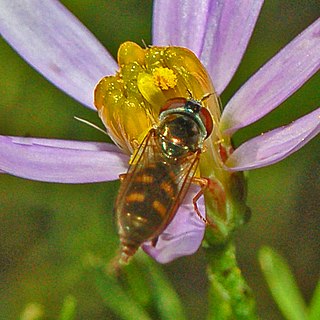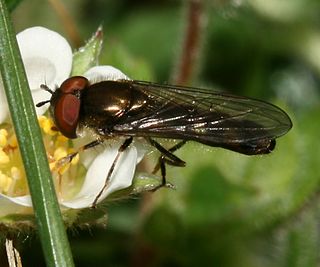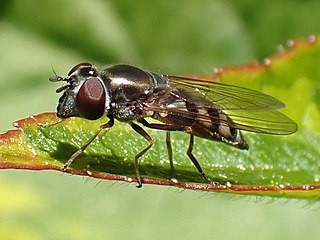
Platycheirus clypeatus is a species of hoverfly. It is found across the Palearctic and in the Nearctic. The larvae feed on aphids. Adults are usually found on the edges of woodland or scrub, heath or along hedgerows where they visit a wide range of flowers.

Platycheirus scutatus is a very common species of hoverfly. It is a Holarctic species.

Platycheirus albimanus is a common widespread species of hoverfly. A holarctic species its range includes Greenland, Iceland, Britain, mainland Europe, Russia, across Siberia to the pacific coast, the Philippines, Alaska, western Canada and United States.

Platycheirus manicatus is a species of hoverfly. It is found across the Palearctic and in Alaska.

Platycheirus rosarum is a species of hoverfly found in the Holarctic realm. Like its close relative Platycheirus granditarsus, it can be found in marshy meadows and ditches; indeed, the two species can often be found together. The flight time is between May and October, though it peaks in abundance in June and July.

Platycheirus immarginatus, the Comb-legged Sedgesitter, is a common species of hoverfly. It is found in parts of northern Europe and northern North America.
Platycheirus perpallidus is a species of hoverfly. It is a Holarctic species.

Platycheirus stegnus is a species of syrphid fly in the family Syrphidae.

Platycheirus trichopus, also known as the western forest sedgesitter, is a species of syrphid fly in the Bacchini tribe of the Syrphidae family. This flower fly is typically found west of the Rocky Mountains in North America. Most Platycheirus species cannot be identified past genus without microscopic examination, but according to Even Dankowicz, P. trichopus has a unique set of characteristics that make it an exception when/where high quality images of the head/face are available.

Platycheirus coerulescens, the Hooked Sedgesitter, is a species of syrphid fly in the family Syrphidae.
Platycheirus thylax is a species of syrphid fly in the family Syrphidae.
Platycheirus quadratus is a species of syrphid fly in the family Syrphidae. </ref <ref name=Skevington2019> Skevington, Jeffrey H.; Locke, Michelle M.; Young, Andrew D.; Moran, Kevin; et al. (2019). Field Guide to the Flower Flies of Northeastern North America. Princeton Field Guides. Princeton University Press. ISBN 9780691189406.</ref>
Platycheirus hyperboreus is a species of syrphid fly in the family Syrphidae. In N America hyperboreus is broadly distributed across Alaska, Canada, Greenland and the northern United States, ranging as far south as North Carolina in the east and Nevada. In western and northern Europe ranging from Norway, Finland, northern Russia and on into northern Siberia.
Platycheirus inversus, also known as the knobfoot sedgesitter, is a rare species of syrphid fly observed in Northeastern North America. Hoverflies can remain nearly motionless in flight. The adults are also known as flower flies for they are commonly found on flowers, from which they get both energy-giving nectar and protein-rich pollen. Larvae are aphid predators.
Platycheirus modestus , also known as the yellow sedgesitter, is an uncommon species of syrphid fly observed throughout Northern North America. Hoverflies can remain nearly motionless in flight. The adults are also known as flower flies for they are usually found on flowers from which they get both energy-giving nectar and protein-rich pollen. Larvae are aphid predators.
Platycheirus nodosus, known as the twospear sedgesitter, is an uncommon species of syrphid fly observed in Canada and The Rocky Mountains. Hoverflies can remain nearly motionless in flight. The adults are also known as flower flies for they are commonly found on flowers from which they get both energy-giving nectar and protein-rich pollen. Larvae are aphid predators.
Platycheirus normae, the paddlearm sedgesitter, is a rare species of syrphid fly observed in northeastern North America. Hoverflies can remain nearly motionless in flight. The adults are also known as flower flies for they are commonly found on flowers, from which they get both energy-giving nectar and protein-rich pollen. Larvae are aphid predators.
Platycheirus scamboides, the yellowspine sedgesitter, is a rare species of syrphid fly observed in northeastern North America. Hoverflies can remain nearly motionless in flight. The adults are also known as flower flies for they are commonly found on flowers, from which they get both energy-giving nectar and protein-rich pollen. Larvae are aphid predators.
Platycheirus thompsoni, or Thompson's sedgesitter, is an uncommon species of syrphid fly observed in northeastern North America. Hoverflies can remain nearly motionless in flight. The adults are also known as flower flies, for they are commonly found on flowers, from which they get both energy-giving nectar and protein-rich pollen. Larvae are aphid predators.
Platycheirus varipes is a rare species of syrphid fly observed in Northern Europe: Norway, Sweden, Finland; Greenland; central Asiatic Russia; and in North America from Alaska and Canada south to Colorado, via mountain chains.










